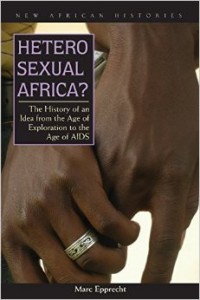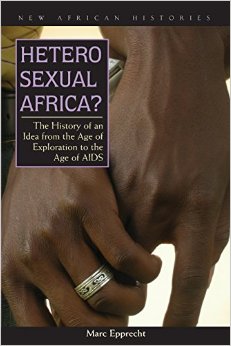 Heterosexual Africa?: The History of an Idea from the Age of Exploration to the Age of AIDS
Heterosexual Africa?: The History of an Idea from the Age of Exploration to the Age of AIDS
by Marc Epprecht
Ohio University Press. 231 pages, $19.95
THE IDEA that homosexuality can be imported from one country (or continent) to the next like a bag of exotic coffee beans is a persistent notion in colonial lore. The myth has especially strong roots when it comes to the continent of Africa. We’ve all heard the charge: Africa never had a “problem” with homosexuality before colonization, when those nasty French and English settlers, decked out in their imperialist safari hats, planted the seeds of sodomy on the continent.
Heterosexual Africa? explores how Africa’s singular identity as a heterosexual continent came about.
Epprecht reports on researchers like Ferdinand Karsch-Haack, who investigated hunter-gatherers in Angola and Namibia and came to the conclusion that homosexuality was innate to all humankind. “We should finally give up the fiction that Sodom and Gomorrah are only in Europe and that everywhere else holy customs reign,” wrote Karsch-Haack. “The most unnatural vices, which we regard as the most recent ways of stimulation of an over civilized culture, are practiced there in the light of day, in the open, as common practice.” Slivers of truth like this tended to get buried under avalanches of other research that hid the facts about homosexual behavior in Africa.
Notwithstanding the explorers’ and anthropologists’ reticence, it does appear that some of the secrecy when it came to homosexuality originated with the native peoples themselves. Indeed this secrecy among Africans calls to mind the contemporary African-American phenomenon known as the “down low,” which provides an outlet for homosexual activity but proscribes any mention of it in legitimate society. Given these dual sources of secrecy, discerning the truth about African homosexuality is a researcher’s nightmare.
On one hand, explorers offered reports of uninhibited African sexuality in the heterosexual world, where even “outrageous” practices (by European standards) were said to be tolerated. On the other hand, in addition to under-reporting homosexual practices, many early anthropologists claimed that homosexual acts were heavily prosecuted. None of these contentions is to be taken at face value, argues Epprecht: “Universalist claims about extreme intolerance of sexual diversity or gender variance clearly flew in the face of considerable other work.” As a counterexample, many researches noted the widespread presence of “mine marriages” between males who were migrant labor Africans in regions of southern Africa and in French North and West Africa. “In mine marriages men took younger men or boys as servants and ‘wives’ for the duration of their employment contracts. … These temporary male-male marriages often served to strengthen traditional marriage with women back in the rural areas. Boy wives allowed the men to avoid costly and potentially unhealthy relationships with female prostitutes in town.”
This is not a book that one races through in a week, and one could hardly call it a page turner. In sober academic prose strewn with statistics and footnotes, Heterosexual Africa? is a book that requires a fair amount of heavy plowing to reach the other side.
Thom Nickels’ books include Philadelphia Architecture and Out in History. His novel SPORE will be released in 2010.







